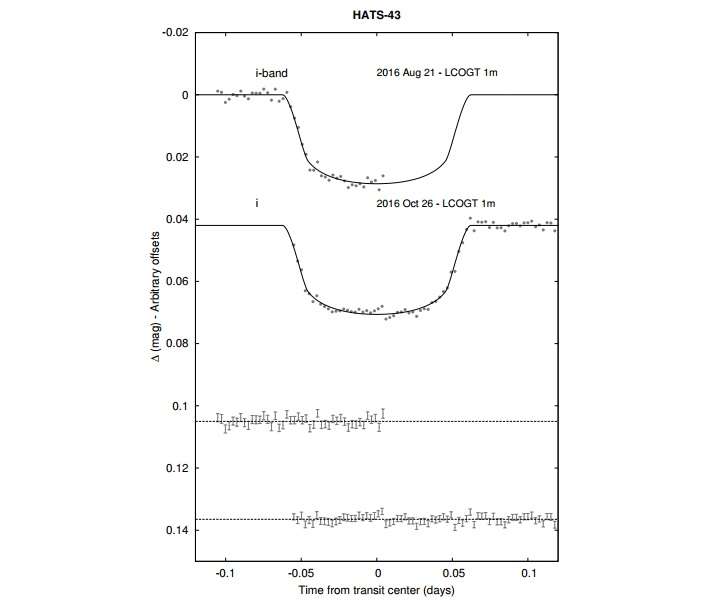July 26, 2017 report
Four new short-period giant planets discovered

(Phys.org)—Astronomers have detected four new giant exoplanets as part of the Hungarian-made Automated Telescope Network-South (HATSouth) exoplanet survey. The newly found alien worlds are about the size of Jupiter, but less massive. They transit moderately bright stars and have short orbital periods. The findings were presented July 22 in a paper published on arXiv.org.
HATSouth is a network of six astrograph telescope systems located in South America, Africa, and Australia. These telescopes are designed to detect transiting extrasolar planets in orbit around relatively bright stars visible from the Southern hemisphere. Since its launch in 2009, the network has already detected dozens of transiting exoplanets.
Now, the list of planets detected by HATSouth has expanded. In a recent paper, a team of researchers led by Rafael Brahm of the Pontifical Catholic University of Chile in Santiago presents the discovery of four new planets, HATS-43b, HATS-44b, HATS-45b, and HATS-46b. The planetary nature of transiting signals detected by HATSouth was confirmed by follow-up spectroscopic and photometric observations using various instruments, including the Las Cumbres Observatory Global Telescope (LCOGT) network at the Cerro Tololo International Observatory (CTIO) in Chile.
This extensive observational campaign that led to the discovery of four new alien worlds was carried out from December 2009 to October 2016.
"We have presented the discovery of four new short-period transiting systems from the HATSouth network. The systems were identified as planetary candidates using HATSouth photometric light curves and then confirmed as planetary mass objects by measuring precise radial velocities for the host stars," the astronomers wrote in the paper.
According to the paper, HATS-45b is the largest and most massive exoworld of all the newly discovered exoplanets. It has a radius of about 1.29 Jupiter radii and is 30 percent less massive than our solar system's biggest planet. It orbits its parent star every 4.19 days.
HATS-46b has the longest orbital period and is the least massive of the newly found quartet. It has only 17 percent of the mass of Jupiter, however a radius of approximately 0.9 Jupiter radii. It takes this planet 4.74 days to fully circle its host.
HATS-43b and HATS-44b are similar in radius—1.18 and 1.07 Jupiter radii respectively. HATS-43b has a mass of 0.26 Jupiter masses, while HATS-44b is about two times more massive—0.56 Jupiter masses. The shortest orbital period among the four newly identified planets belongs to HATS-44b, which orbits its star in just 2.74 days. When it comes to HATS-43b, it takes it approximately 4.39 days to circle its parent star.
In general, the newly found planets have orbital periods shorter than five days and masses in the Neptune to Jupiter mass range, however all of them have radii similar to that of Jupiter.
The researchers concluded that their finding is an important addition to the still-growing collection of planetary systems with determined basic parameters.
"These four new systems add to the valuable population of extrasolar planets transiting stars with precisely determined masses and radii," the paper reads.
More information: HATS-43b, HATS-44b, HATS-45b, and HATS-46b: Four Short Period Transiting Giant Planets in the Neptune-Jupiter Mass Range, arXiv:1707.07093 [astro-ph.EP] arxiv.org/abs/1707.07093
Abstract
We report the discovery of four short period extrasolar planets transiting moderately bright stars from photometric measurements of the HATSouth network coupled to additional spectroscopic and photometric follow-up observations. While the planet masses range from 0.26 to 0.90 MJ, the radii are all approximately a Jupiter radii, resulting in a wide range of bulk densities. The orbital period of the planets range from 2.7d to 4.7d, with HATS-43b having an orbit that appears to be marginally non-circular (e= 0.173±0.089). HATS-44 is notable for a high metallicity ([Fe/H]= 0.320±0.071). The host stars spectral types range from late F to early K, and all of them are moderately bright (13.3
© 2017 Phys.org





















